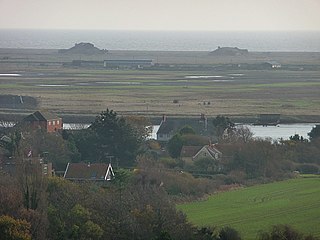 Southwold lighthouse | |
| Location | Southwold, Suffolk |
|---|---|
| Coordinates | 52°19′38″N01°40′53″E / 52.32722°N 1.68139°E Coordinates: 52°19′38″N01°40′53″E / 52.32722°N 1.68139°E |
| Year first constructed | 1890 |
| Automated | 1938 |
| Construction | brick tower |
| Tower shape | cylindrical tower with balcony and lantern |
| Markings / pattern | white tower and lantern |
| Tower height | 31 metres (102 ft) |
| Focal height | 37 metres (121 ft) |
| Original lens | 1st order 920mm focal length, catadioptric fixed lens |
| Current lens | Pelangi PRL400TH |
| Intensity | 17,100 candela |
| Range | 24 nautical miles (44 km) |
| Characteristic | White rotating – flashing once every 10 seconds |
| Admiralty number | A2272 |
| NGA number | 1588 |
| ARLHS number | ENG 135 |
| Managing agent | Southwold Millennium Foundation [1] |
| Heritage | Grade II listed building |
Southwold lighthouse is a lighthouse operated by Trinity House in the centre of Southwold in Suffolk, England. It stands on the North Sea coast, acting as a warning light for shipping passing along the east coast and as a guide for vessels navigating to Southwold harbour.

A lighthouse is a tower, building, or other type of structure designed to emit light from a system of lamps and lenses and to serve as a navigational aid for maritime pilots at sea or on inland waterways.

The Corporation of Trinity House of Deptford Strond, known as Trinity House, is a private corporation governed under a Royal Charter.

Southwold is a small town and civil parish on the English North Sea coast in the East Suffolk district of Suffolk. It lies at the mouth of the River Blyth within the Suffolk Coast and Heaths Area of Outstanding Natural Beauty. The town is about 11 miles (18 km) south of Lowestoft, 29 miles (47 km) north-east of Ipswich and 97 miles (156 km) north-east of London, within the parliamentary constituency of Suffolk Coastal. The "All Usual Residents" 2011 Census figure gives a total of 1,098 persons for the town. The 2012 Housing Report by the Southwold and Reydon Society concluded that 49 per cent of the dwellings in the town are used as second homes and let to holiday-makers.
Contents
The lighthouse, which is a prominent local landmark, was commissioned in 1890, and was automated and electrified in 1938. It survived a fire in its original oil-fired lamp just six days after commissioning and today operates a 180-watt main navigation lamp. This lamp has a range of 24 nautical miles (44 km; 28 mi). [2]


























